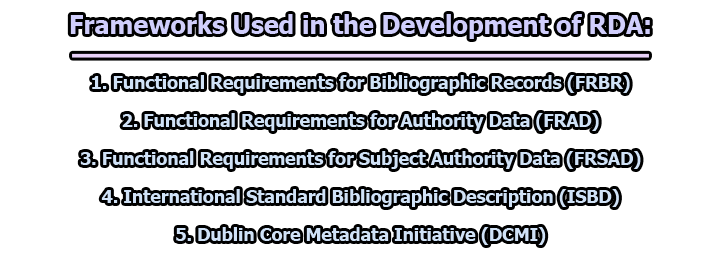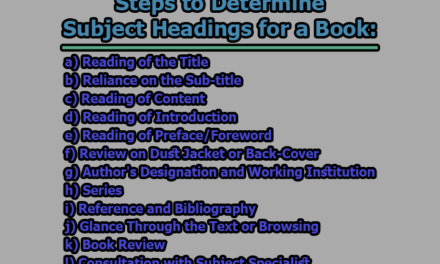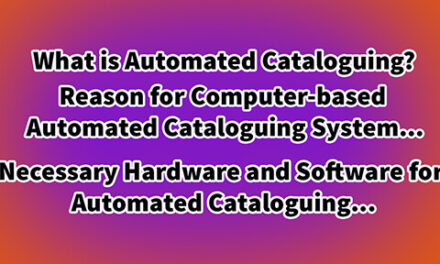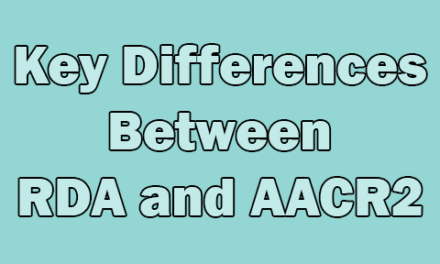Frameworks Used in the Development of RDA:
Resource Description and Access (RDA) is a set of cataloging instructions designed for the digital environment. It provides guidelines for the description of all types of resources, including both traditional and digital, ensuring consistency and interoperability in library catalogs. The development of RDA involves the use of various frameworks to structure and organize the cataloging process efficiently. In this article, we will explore some of the essential frameworks used in the development of RDA.
1. Functional Requirements for Bibliographic Records (FRBR):
The Functional Requirements for Bibliographic Records (FRBR) is a conceptual model that significantly influenced the development of RDA. FRBR was introduced by the International Federation of Library Associations and Institutions (IFLA) to address the challenges associated with traditional cataloging practices and to provide a more user-centric and hierarchical approach to bibliographic description.
Key Concepts of FRBR:
- Work: The abstract entity that represents a distinct intellectual or artistic creation. A work may exist in multiple expressions and manifestations.
- Expression: The specific intellectual or artistic form a work takes, such as a particular edition, translation, or adaptation.
- Manifestation: The physical embodiment of an expression of a work, representing a specific version or edition.
- Item: A single exemplar of a manifestation, such as a copy of a book or a specific instance of a digital resource.
Impact on RDA Development:
- Hierarchy in Description: FRBR introduced a clear hierarchical structure to bibliographic entities, emphasizing the relationships between works, expressions, manifestations, and items. RDA adopts this hierarchy to ensure that cataloging reflects the inherent relationships among different versions and formats of a resource.
- User-Focused Approach: FRBR shifts the focus from a cataloging perspective to a user-centric perspective, recognizing that users seek information at different levels of abstraction. RDA, building on this principle, aims to enhance user experience by providing more meaningful and contextually relevant access points.
- Entity-Relationship Model: FRBR’s entity-relationship model serves as a foundational framework for RDA. This model guides catalogers in determining the attributes and relationships between various entities, contributing to the consistency and coherence of bibliographic records.
- Collocation of Resources: FRBR addresses the issue of collocation, ensuring that all expressions and manifestations of a particular work are grouped together in the catalog. RDA incorporates these principles to facilitate the discovery of related resources and to streamline access to a variety of versions of a work.
Incorporating the principles of FRBR into RDA represents a fundamental shift in cataloging methodologies. The emphasis on hierarchy, user-centricity, and relationships between entities ensures that RDA provides a more flexible and intuitive framework for describing bibliographic resources in both traditional and digital environments. FRBR’s influence on RDA contributes significantly to the adaptability and effectiveness of cataloging practices in modern libraries.
2. Functional Requirements for Authority Data (FRAD):
Functional Requirements for Authority Data (FRAD) is a conceptual model that extends the principles of FRBR to the realm of authority data, focusing on the entities of persons, corporate bodies, and works. FRAD provides guidelines for creating consistent and interoperable authority records, ensuring that these records are structured and maintained in a manner that supports the identification and collocation of related resources.
Key Concepts of FRAD:
- Person: The entity representing an individual, either real or fictional, responsible for the creation or intellectual content of a work.
- Corporate Body: An organization or group that is responsible for the creation, production, or custodianship of a work.
- Family: A group of persons related by blood, marriage, adoption, or similar legal ties.
- Work: In the context of authority data, FRAD addresses the identification and representation of works, emphasizing the importance of disambiguating between works with similar or identical titles.
Impact on RDA Development:
- Comprehensive Authority Control: FRAD ensures that authority records are not limited to personal names but also encompass corporate bodies and works. RDA adopts these principles to provide comprehensive authority control, facilitating accurate identification and disambiguation of entities across the bibliographic universe.
- Relationships between Entities: FRAD emphasizes the relationships between entities, helping establish connections between the creators (persons, corporate bodies, families) and the works they produce. RDA leverages these relationships to create richer and more contextually relevant authority records.
- Consistency in Data: FRAD promotes consistency in the data elements used in authority records. RDA aligns with these principles to ensure that authoritative information is uniformly presented, contributing to the reliability of the cataloging data.
- Linking Authority and Bibliographic Records: FRAD encourages the linking of authority and bibliographic records, strengthening the connection between the controlled access points in authority records and the corresponding bibliographic descriptions. RDA integrates these linking practices to enhance the retrieval of resources through authority-controlled access points.
The amalgamation of FRAD principles into RDA extends the benefits of a well-structured conceptual model to authority data, enhancing the accuracy and reliability of information about persons, corporate bodies, and works. By emphasizing relationships, comprehensive control, and consistent data, FRAD ensures that RDA provides a robust framework for creating and managing authority records in libraries, thereby contributing to improved resource identification and organization.
3. Functional Requirements for Subject Authority Data (FRSAD):
Functional Requirements for Subject Authority Data (FRSAD) is an extension of the FRBR and FRAD models, focusing specifically on the conceptualization and representation of subject concepts in authority data. While FRBR and FRAD primarily address bibliographic and authority data related to creators and works, FRSAD provides a framework for describing and controlling the subject aspects of resources.
Key Concepts of FRSAD:
- Subject: FRSAD defines subject as a broad and flexible concept, encompassing topics, themes, genres, and other facets that represent the content or intellectual theme of a work.
- Object: Objects are the entities or things that are the focus of a work’s subject, providing a link between the subject and the physical or conceptual entities being discussed.
- Concept: The abstract ideas or notions associated with a subject, providing a higher-level conceptualization beyond specific objects.
- Event: Events represent actions or occurrences that are integral to the subject matter of a work.
Impact on RDA Development:
- Comprehensive Subject Access: FRSAD broadens the scope of authority data to include subject-related entities, allowing RDA to provide comprehensive subject access points. This inclusion ensures that users can discover resources based not only on creators and titles but also on the subjects they cover.
- Faceted Approach: FRSAD introduces a faceted approach to subject representation, acknowledging that subjects have multiple dimensions. RDA incorporates this approach, allowing for a more nuanced and detailed representation of the various aspects of a subject, contributing to improved resource discovery.
- Relationships between Subjects: FRSAD emphasizes relationships between different subject entities, acknowledging the interconnectedness of subjects in the intellectual landscape. RDA utilizes these relationships to enhance the contextualization of subjects, helping users explore related topics and themes.
- Integration with Bibliographic Records: FRSAD encourages the integration of subject authority data with bibliographic records, ensuring that subject access points are seamlessly incorporated into the overall resource description. RDA follows these principles, promoting a holistic approach to bibliographic control that encompasses both creators and subjects.
The incorporation of FRSAD principles into RDA reflects a commitment to providing a comprehensive and multifaceted approach to resource description in libraries. By addressing the complexities of subject representation, FRSAD enhances the ability of RDA to facilitate subject access, contributing to a more inclusive and user-friendly cataloging framework that goes beyond traditional author-title access points.
4. International Standard Bibliographic Description (ISBD):
The International Standard Bibliographic Description (ISBD) is a set of rules that provides a standardized framework for the bibliographic description of resources. Originally developed by the International Federation of Library Associations and Institutions (IFLA), ISBD aims to ensure consistency and clarity in the presentation of bibliographic information, promoting international communication and resource sharing among libraries.
Key Concepts of ISBD:
- Elements of Description: ISBD defines specific elements that should be included in the bibliographic description of a resource. These elements cover essential information such as title, statement of responsibility, edition, publication details, and physical description.
- Order of Elements: ISBD provides guidelines for the order in which bibliographic elements should be presented in a bibliographic record, contributing to a standardized and predictable structure.
- Punctuation and Formatting: ISBD outlines rules for punctuation and formatting to be used in bibliographic records, ensuring consistency in the presentation of information across different catalogs and systems.
- Abbreviations: ISBD specifies the use of standardized abbreviations for certain terms and elements, reducing ambiguity and facilitating international understanding.
Impact on RDA Development:
- Alignment with International Standards: RDA aligns with ISBD principles to ensure that bibliographic records created using RDA are compatible with international standards. This alignment facilitates interoperability and the exchange of bibliographic information between libraries globally.
- Consistency in Presentation: ISBD’s emphasis on a consistent structure and presentation of bibliographic information influences the way RDA organizes and presents cataloging data. This consistency enhances user comprehension and navigation within library catalogs.
- Interoperability: By adhering to ISBD, RDA contributes to the interoperability of library catalogs. Libraries worldwide can exchange bibliographic records with confidence that the data will be structured and presented in a standardized manner, promoting seamless resource discovery.
- Facilitation of Resource Sharing: ISBD’s focus on standardization and clarity supports resource sharing initiatives among libraries. RDA, by incorporating ISBD principles, ensures that cataloging practices are conducive to collaborative endeavors and cooperative collection development.
The integration of ISBD principles into RDA highlights the importance of standardized bibliographic description for effective communication and collaboration in the library community. By aligning with ISBD, RDA contributes to the creation of bibliographic records that are not only user-friendly but also interoperable on a global scale. The collaboration between RDA and ISBD reinforces the goal of facilitating resource discovery and sharing in an increasingly interconnected and international library landscape.
5. Dublin Core Metadata Initiative (DCMI):
The Dublin Core Metadata Initiative (DCMI) is a collaborative effort to develop a standardized set of metadata elements to describe digital resources. Originally focused on web resources, DCMI provides a simple and interoperable framework for describing a wide range of materials. It serves as a foundation for metadata creation and management, facilitating resource discovery and interoperability in various information systems.
Key Concepts of DCMI:
- Elements: DCMI specifies a set of basic metadata elements, such as title, creator, subject, description, publisher, contributor, date, type, format, identifier, source, language, and relation. These elements provide a core set of descriptive information for digital resources.
- Simplicity: DCMI emphasizes simplicity to ensure that metadata creation is accessible and practical for a wide range of users. This simplicity is crucial for encouraging widespread adoption and implementation across diverse contexts.
- Interoperability: DCMI’s focus on interoperability aims to facilitate the exchange of metadata between different systems and domains. The use of common metadata elements enhances the ability of information systems to understand and process metadata from various sources.
- Extensibility: DCMI allows for the creation of application profiles, enabling communities to extend the core set of elements to meet specific needs. This flexibility ensures that the framework can be adapted to accommodate diverse resource types and user requirements.
Impact on RDA Development:
- Metadata Interoperability: RDA incorporates DCMI principles to enhance the interoperability of library metadata with other information systems. This alignment facilitates the integration of library data into broader digital environments and contributes to a more interconnected information ecosystem.
- Simplicity and Accessibility: By embracing the simplicity advocated by DCMI, RDA strives to make metadata creation and management more accessible to catalogers. This user-friendly approach encourages effective cataloging practices and supports the creation of quality metadata.
- Cross-Domain Collaboration: DCMI’s emphasis on interoperability aligns with the broader goals of RDA to foster collaboration and resource sharing across different domains. The integration of DCMI principles in RDA supports cross-disciplinary access to information resources.
- Flexibility and Extensibility: RDA’s incorporation of DCMI principles allows for flexibility and extensibility in describing a wide variety of resources. This adaptability is particularly important in the evolving landscape of digital information, where new types of resources constantly emerge.
The collaboration between RDA and the Dublin Core Metadata Initiative reflects a commitment to creating a flexible, interoperable, and user-friendly framework for resource description. By integrating DCMI principles, RDA acknowledges the importance of aligning library metadata practices with broader standards, thereby contributing to a more cohesive and interconnected information environment. The shared principles of simplicity, interoperability, and extensibility promote effective resource discovery and access across diverse information systems and domains.
In conclusion, the development of RDA is rooted in the integration of various frameworks that collectively provide a robust foundation for resource description in the library context. These frameworks, such as FRBR, FRAD, FRSAD, ISBD, and DCMI, contribute to the clarity, consistency, and interoperability of cataloging practices. By adopting and adapting these frameworks, RDA continues to evolve, addressing the challenges posed by the dynamic nature of information resources in the digital age. The collaborative and interdisciplinary approach embedded in these frameworks reinforces RDA’s position as a vital tool for enhancing resource discovery and access in libraries worldwide.

Assistant Teacher at Zinzira Pir Mohammad Pilot School and College










